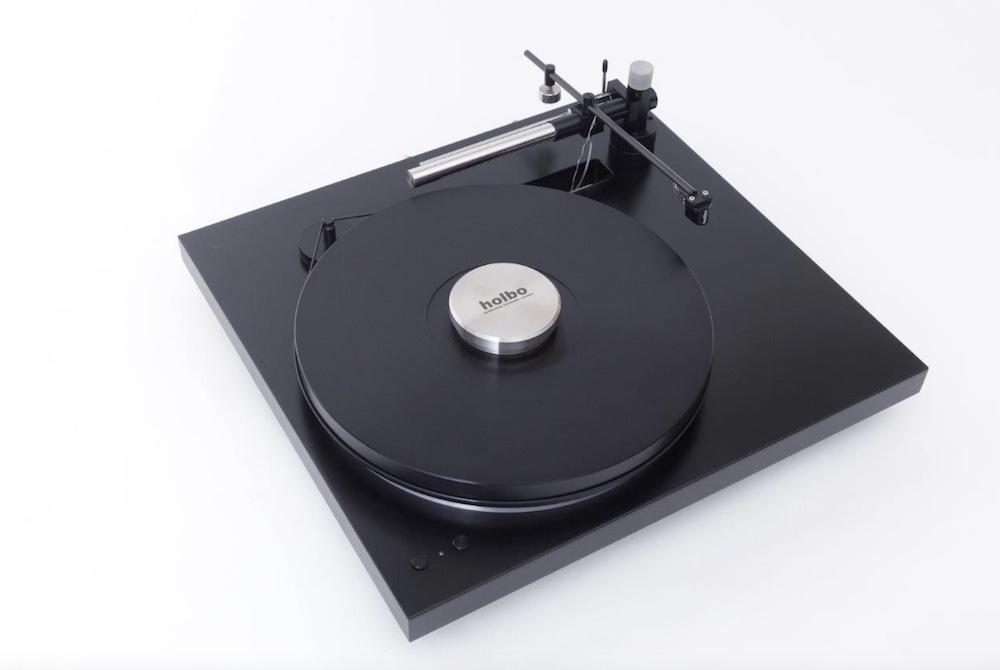Holbo Mk2 Airbearing Turntable System
make it two from Slovenia
A $7900 turntable featuring an air bearing tangential tracking tonearm and an air bearing platter? Sounds too good to be true, and if it is true, what’s the catch? There must be a catch. I first spotted the manufactured in Slovenia Holbo at Munich High End 2022 and it sure caught my attention. It’s featured in a YouTube video I shot at that show, but with no American importer then, a review didn’t make sense. Now there is one: Metavoxaudio so now’s the time for a Holbo Mk2 review. Full disclosure: the importer is a longtime friend of mine. Deal with it.
What It Is
The matte black 1.2” tall, 17”x16” MDF plinth sits on a trio of level-adjustable, spike-terminated cylindrical feet and accompanying platform protecting aluminum pucks. It’s well-finished and despite its simplicity, makes for a pleasing looking presentation.
A Japan-sourced electronically controlled D.C. motor drives the air-supported eleven-pound CNC-machined 6082 aluminum platter, via a cylindrical black rubber belt fitted around the platter’s grooved periphery and what appears to be a one piece motor shaft/pulley protruding from a small, raised circular platform atop the plinth. As with everything else about this remarkably well-conceived, elegant design, the motor shaft doesn’t simply protrude from a hole—as you can see in the picture. The platter bearing’s center pin/spindle is made of POM thermoplastic and hardened steel.
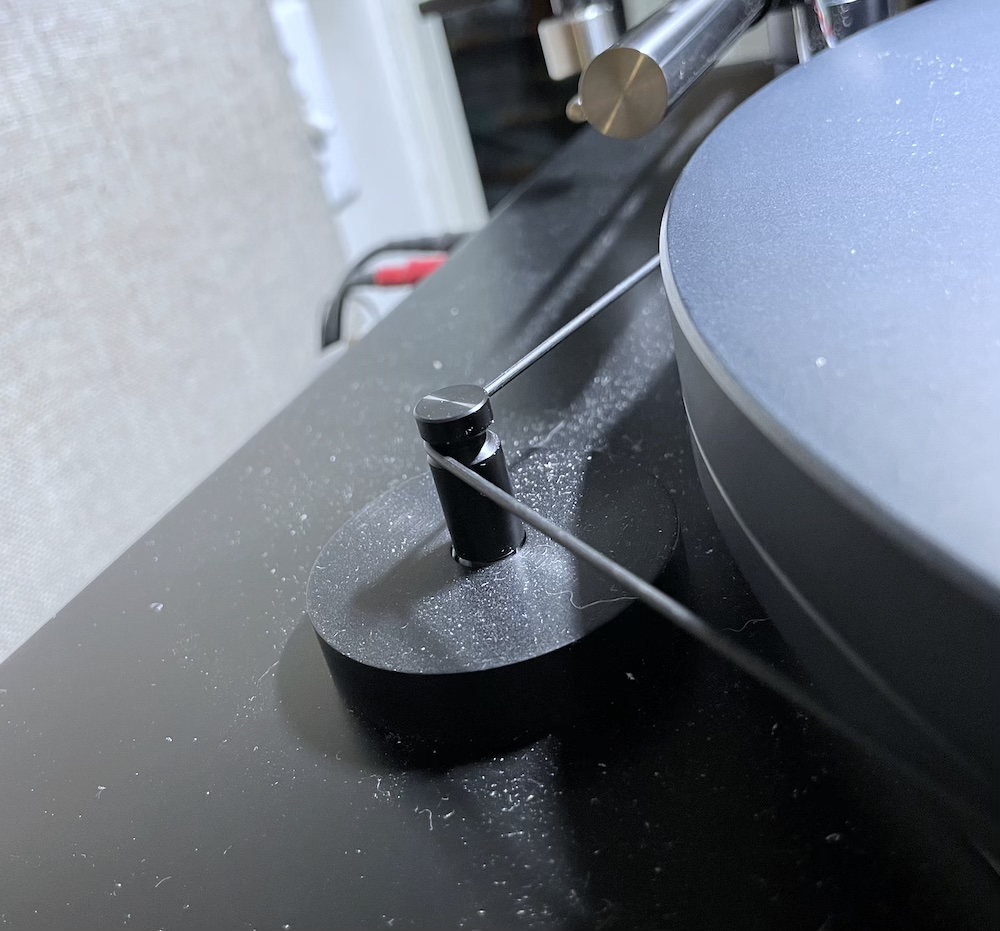 I should mention here that this turntable for whatever reason or reasons is a static electricity producing dust magnet. A pair of push buttons at the plinth front left, one on either side of a small LED, control on/off and choice of 33 1/3 or 45rpm. Depressing the left button pressurizes the platter bearing and actuates the motor, which quickly spins at 33 1/3. The LED glows red. Depressing the right-hand button changes red to green and ups the speed to 45rpm.
I should mention here that this turntable for whatever reason or reasons is a static electricity producing dust magnet. A pair of push buttons at the plinth front left, one on either side of a small LED, control on/off and choice of 33 1/3 or 45rpm. Depressing the left button pressurizes the platter bearing and actuates the motor, which quickly spins at 33 1/3. The LED glows red. Depressing the right-hand button changes red to green and ups the speed to 45rpm.
 The tangentially tracking, 6.4” effective length, pencil-diameter tonearm, fabricated from aluminum alloy and carbon, rides on an actual captured air bearing, not on a “hovercraft” floating on air blowing up from holes machined into a rail. A set screw securing the rod within a carrier frame allows adjustment of overhang and azimuth.
The tangentially tracking, 6.4” effective length, pencil-diameter tonearm, fabricated from aluminum alloy and carbon, rides on an actual captured air bearing, not on a “hovercraft” floating on air blowing up from holes machined into a rail. A set screw securing the rod within a carrier frame allows adjustment of overhang and azimuth.
 The bearing assembly is attached to a vertical assembly that can be raised and lowered to set VTA/SRA and the baseplate lets you easily level the bearing rail. A sliding hanging weight riding on the tonearm rear adjusts tracking force. All neatly conceived and cleanly delivered.
The bearing assembly is attached to a vertical assembly that can be raised and lowered to set VTA/SRA and the baseplate lets you easily level the bearing rail. A sliding hanging weight riding on the tonearm rear adjusts tracking force. All neatly conceived and cleanly delivered.
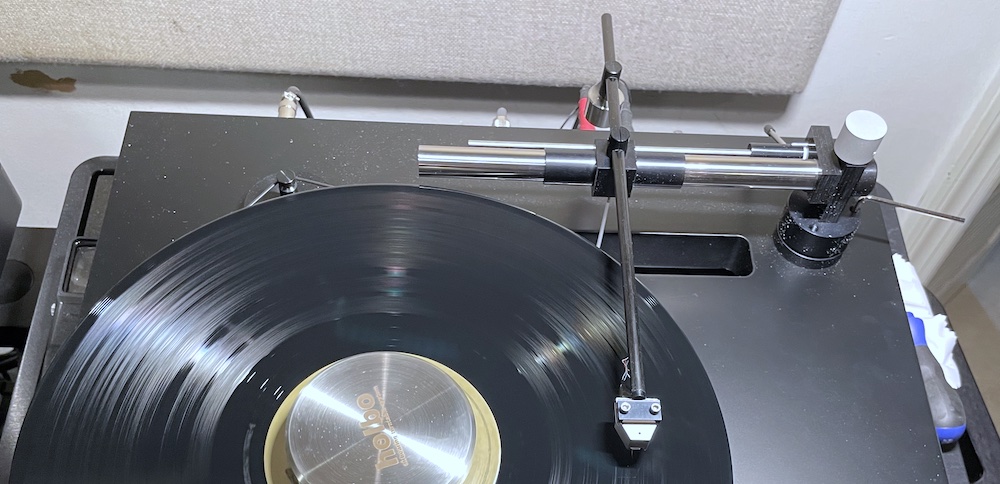 In the photo the allen key is inserted into the rail leveling adjustment screw.
In the photo the allen key is inserted into the rail leveling adjustment screw.
A remarkably small, quiet pump/power supply delivers pressurized air to both bearings, and power to the motor controller. The plinth rear panel features a ground post, RCA jacks, an air inlet from the pump tubing, 33 1/3 and 45 speed adjustment screws and a multi-pin DC power supply input. Accessories include a substantial record weight, strobe disc, air tubing, and set-up tools.
Set Up
The Holbo exits the shipping box with the arm and platter in place. Once placed on its platform and leveled using the adjustable feet, and you’ve placed the protective cups under the spikes, the belt goes around the pulley and platter, and you connect the air tubing and the multi-pin power adapter to the back of the plinth and to the pump box.
Next you power up the pump and the platter spins allowing you to use the strobe disc to adjust the speed for both 33 1/3 and 45rpm via a pair of pots set into the plinth rear. Leveling is critical for any tonearm but more so for an air bearing tangential tracker because the high horizontal mass can’t be allowed to slide the arm in either direction.
Since the platter spins automatically when you push the button you first have to remove the belt and then push to energize the arm bearing after which you install your cartridge of choice, place the linear alignment gauge on the platter and set tracking force to barely touching the platter surface.
The arm will most likely slide one way or the other. A single screw on the arm’s right side lets you easily level the rail until the arm doesn’t move. Another easy adjustment lets you level the arm tube with the platter to “set VTA”, which as we all know is a rough approximation, but should you choose to use a digital microscope (or a WallyScope) the adjustment is non-fiddly. So far easy, right?
The Art of the Screw
Now comes the tricky part: you loosen the single screw securing the arm tube to the bearing carrier and set the “overhang” (it’s not really “overhang” but we’ll call it that) to produce a tangential line from the platter’s outer edge to the spindle’s center for the stylus to travel. Then you tighten the screw just enough for it to not move.
 Setting the tracking force can then take you a really long time as you loosen the counterweight set screw and slide it to set VTF. It’s difficult to control, especially to make minor adjustments.
Setting the tracking force can then take you a really long time as you loosen the counterweight set screw and slide it to set VTF. It’s difficult to control, especially to make minor adjustments.
Once that’s done you should do a serious VTA/SRA adjustment (unless you are content with just putting arm parallel to the platter) and then adjust azimuth, but to do that you again loosen that set screw and when you rotate the arm tube chances are good you’ll upset “overhang”, which of course will change VTF!
Other arms are easier to set up, but I usually find when lower cost is involved you pay the price of fiddly adjustability. It’s a worthwhile trade-off if the arm performs. Once everything is set it’s time to play records!
Oh, one final thing before moving on: tangential trackers often have a problem with how to get the tonearm wires out of the way, so they don’t interfere with arm travel since instead of pivoting around a fixed point the entire arm is moving. The air hose is also a potential sticking point. I have no doubt the wires and tube are having some effect on free arm travel but the designer smartly runs them directly down from the bearing and into a channel cut into the plinth.
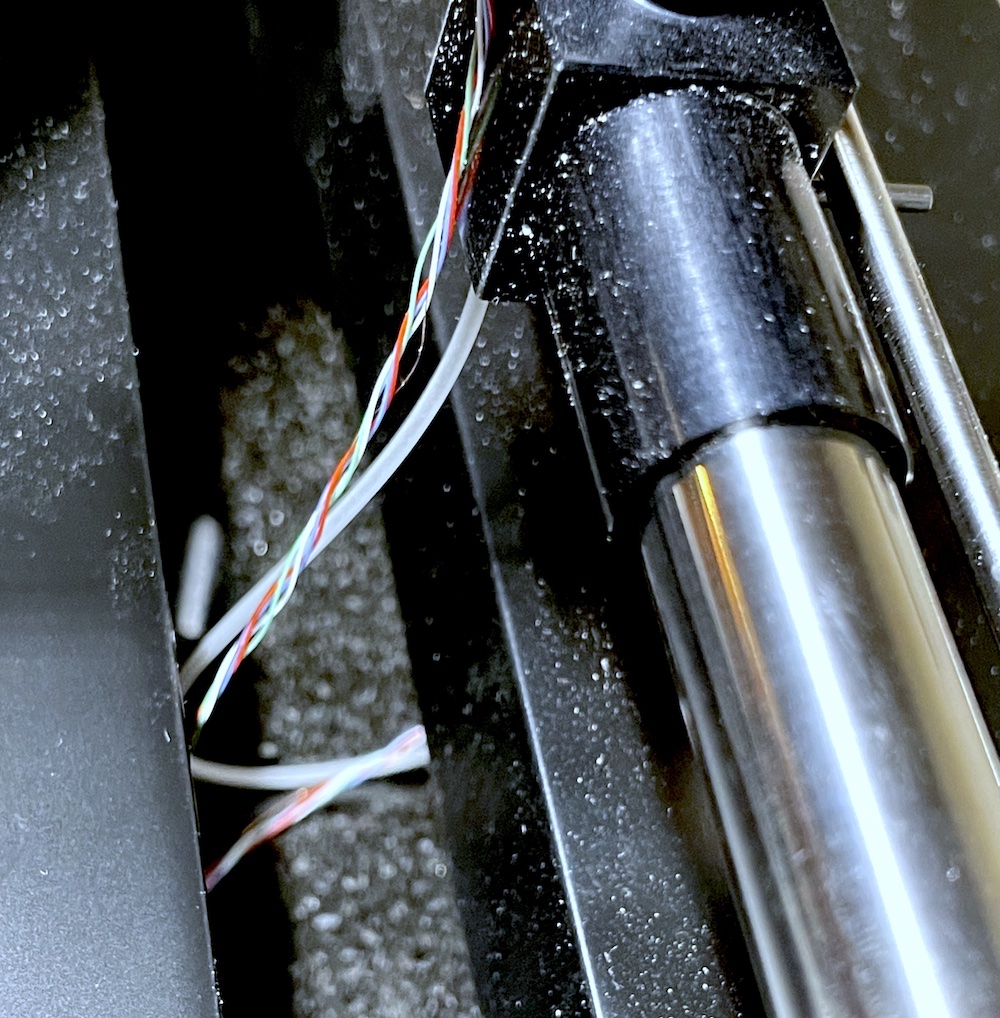 That seems to work fine but it also leaves both the delicate tonearm wires and the hose exposed hanging underneath the plinth so be very careful about storing anything under the plinth! That head’s up ought to be in the instruction manual.
That seems to work fine but it also leaves both the delicate tonearm wires and the hose exposed hanging underneath the plinth so be very careful about storing anything under the plinth! That head’s up ought to be in the instruction manual.
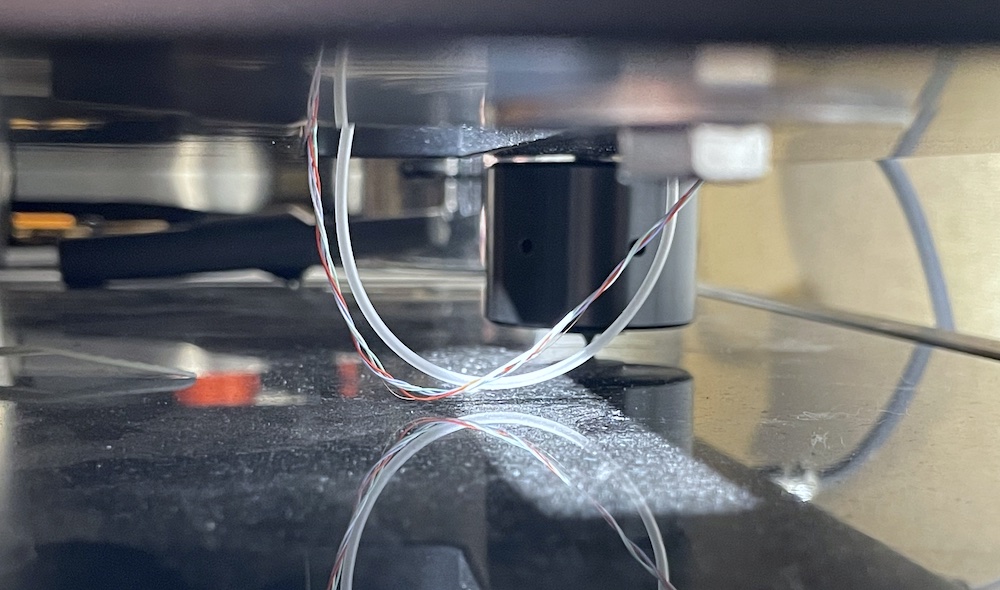 Low hanging fruit
Low hanging fruit
Skeptical Taps
The pencil-thin arm tube seemed like a good place to look for problems. I tapped it with the volume up expecting a “lively” response out of the speakers but there was none. I removed the belt and lowered the stylus onto the record surface and tapped the plinth—described as a “simple” piece of MDF—expecting to hear a resonant “boink” out of the speaker. I heard only the hint of a midfrequency "pop". I restored the belt and snooped around with a stethoscope while a record played expecting to hear motor “whirr” and again I heard nothing. I ran the Shaknspin (https://shaknspin.wordpress.com), and the results were outstanding (understand, the device, which uses a 9 degree of freedom sensor and measures speed 500 times a second, is useful but not a “scientific instrument”).
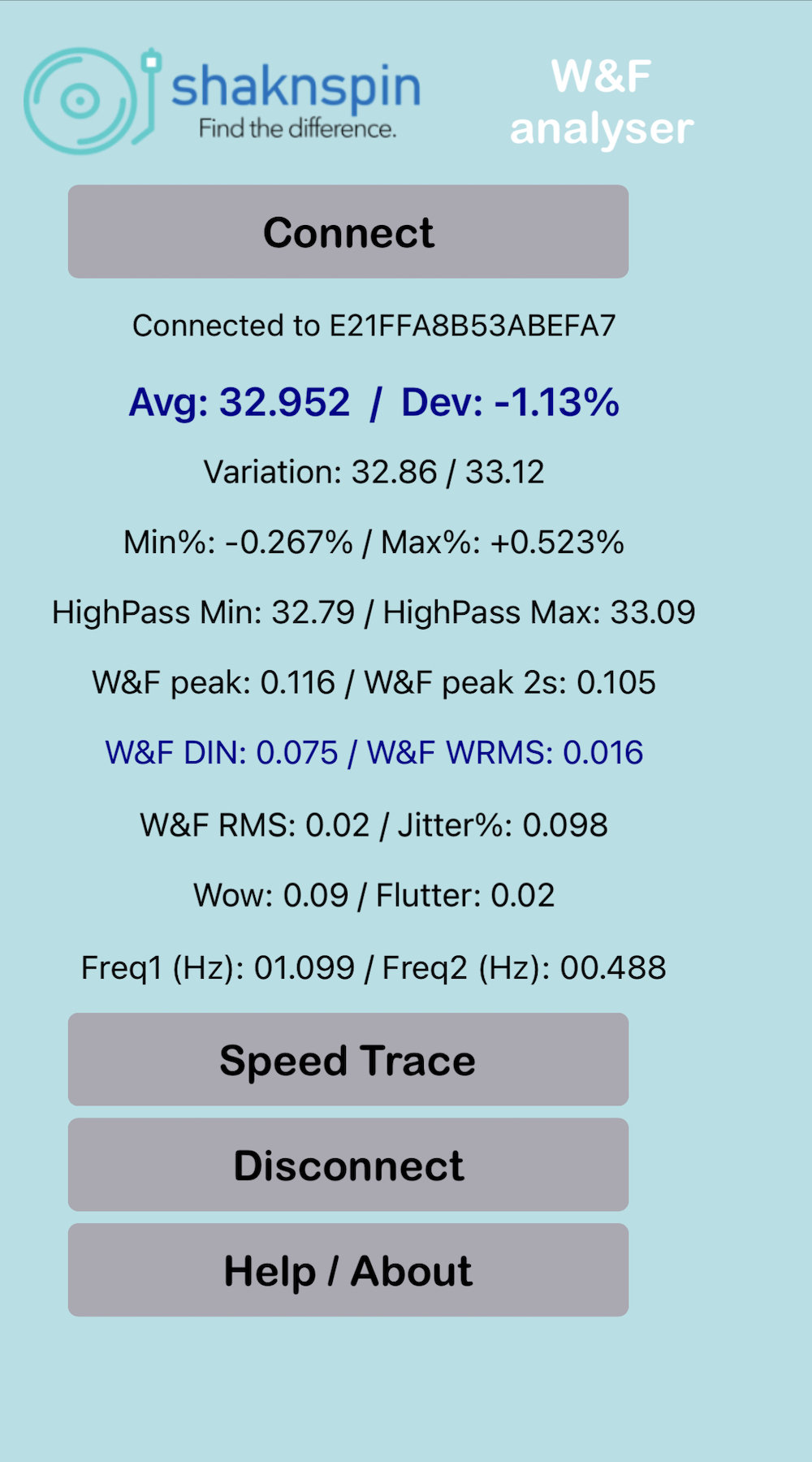 After my initial speed adjustment it ran slightly show a few weeks later. I ran two cartridges on the arm: a Lyra Kleos SL ($3995) and a Miyajima Labs Carbon ($2995). Different compliance specs (12x10-6cm/dyne for Lyra, 9x10-6cm/dyne for Miyajima) but both produced arm/cartridge resonant frequencies within the idea 8-12Hz range.
After my initial speed adjustment it ran slightly show a few weeks later. I ran two cartridges on the arm: a Lyra Kleos SL ($3995) and a Miyajima Labs Carbon ($2995). Different compliance specs (12x10-6cm/dyne for Lyra, 9x10-6cm/dyne for Miyajima) but both produced arm/cartridge resonant frequencies within the idea 8-12Hz range.
Nothing I threw at this turntable to discover a weakness stuck!
Holbo Sound
Two very different cartridges produced two very different sounds, which tells you the turntable is doing a good job of getting out of the way and letting the cartridges express themselves.
Many “tangential trackers” look better from our world than they do in the groove where they are moving about fore and aft, up and down and/or “crabbing” their way across the record, producing a series of “mini-arcs” across the record surface, which in my opinion produces more distortion than does a properly designed and set up traditional pivoted arm.
These “traveling” arms produce an attractively huge soundstage and billowing amounts of “air”, but upon closer listening inspection the images on the stage are usually oversized and out of focus.
The massive high pressure tangential air bearing arms usually have a bright signature produced by high frequency oscillations at the annular gap where air pressure has to go from high where the bearing is doing its work, to ambient room air pressure—think of letting go of a filled balloon.
The Holbo bearing appears to be relatively low pressure and super low-tolerance (meaning a “tight” fit that doesn’t roam). This requires superior machining to produce reliable performance. I’ve been “sitting” on this review for months now waiting for the bearing to stick or show problems. There have been none. Not a single glitch.
What’s more, image focus is tight and stable and appropriately sized. No image bloat. After putting both cartridges on far more costly ‘tables (including my reference OMA K3, which costs forty times more than the Holbo) I can confidently report that as I usually find with tangential trackers, while the turntable’s bottom end was certainly not “lacking”, the lowest octaves were not as forcefully presented as they could be, and there’s some lower midbass excess that might actually work favorably in small speaker systems—it’s kind of like what RVG did after cutting deep bass so records would track on most Blue Note clientel’s cheap turntables—up it around 90Hz to give the sonic appearance of bass.
Other than that one somewhat negative observation, the Holbo presented both cartridges in a pleasing and proper light. The Carbon is a darker, more “chocolately”, more muscular sounding cartridge, the Kleos a more open and airy one, with more sharply expressed high frequency transients but with a “velvety” upper midrange with plenty of air and sparkle where appropriate. The Holbo delivered both accurately and its midbass “push” didn’t obscure the Carbon’s notable lower midrange drive.
More importantly the Holbo’s bass was “tuneful” and the notes true. When I played one of the bonus LPs accompanying Warner Music's recent Little Feat’s Sailin’ Shoes Deluxe Edition, the musical grooves were rhythmically solid and sounded pleasingly deep and well defined.
When the foundation is effective, most of what happens above is usually equally good and that was true here. High frequency transients were clean, well defined and sharply drawn where appropriate. The Holbo’s presentation was not “soft and warm” (or young and tender), though its rhythmic presentation was more “relaxed” than “analytical” and sharp-edge, but it was not at all sloppy.
So once I stopped making the usual reviewer-necessary fastidious and maniacal comparisons and just played records, the presentation was 100% satisfying with no omissions or additions that called attention to themselves.
In preparation for a review of the Peter Frampton box from Intervention, I found that the Holbo’s delivery was sufficiently detailed and accurate timbrally, dynamically and in every other performance category to present an useful assessment of the reissues compared to other pressings (that’s coming right up!).
Conclusion
The Holbo Mk2 is an impressively engineered and presented integrated turntable/tonearm combo. It worked flawlessly during the months I had it set up and it never called attention to any shortcomings until it was compared to far more costly turntables. It ran at the correct speed (when properly set), produced quiet backgrounds, was fun to listen to and use and didn’t exhibit any noticeable, impossible to ignore sonic characteristics. It was at all times and with all genres, pleasing, and I hate to use the word, but sometimes it’s appropriate—“musical”.
Were I to make the Holbo my main spinner I’d want to pair it with a cartridge on the more “analytical” side into a speedy solid state phono preamp, but your tastes might differ. I didn’t try the Ortfon A90 but I bet that would be a swell pairing though that one’s no longer manufactured. The point is, the Holbo is good enough to get out of the way and let your transducer and phono preamp choice get you where you want to go.
The Holbo goes right to the top of the $7-9K category. It’s not alone there, but performance-wise it fits right in with others I can think of, including the Rega P10 and the SME 6—you can comment with your other faves at that price point. I’m not particularly good at making lists off the top of my head. Each has its strengths and weaknesses in terms of sonic performance, set-up flexibility etc. but for those who want a tangential tracker that works hard, plays well and doesn’t break—at least this one didn’t and I used it a lot—the Holbo demands your attention. It also won’t break the bank. Once you’re at this price point you’re getting a generous slice of the licorice pizza pie but don’t let anyone tell you you’re getting it all, because you’re not! However, be assured that consuming the Holbo won’t give you indigestion!
Specifications
Turntable:
DC motor
belt driven
aluminum 5 kg platter
air bearing 2.16 kg
Dimensions:
430mmx400mmx150mm
Total weight: 12kg
Tonearm:
linear tracking air bearing tonearm
aluminum alloy/carbon
effective length: 163mm
effective vertical mass: 7.5g
total tonearm mass: 31.6g
Adjustments:
azimuth
leveling
VTA ± 7mm
Wire:
high quality silver/copper litz
Air pump:
power consumption: 10W
dimensions: 225x147x120mm
weight: 1.8kg
Warranty:
1 year from day of purchase, with proof of purchase, all service must be done through the store where the turntable was purchased. Warranty attached to the original buyer only.
Manufacturer Information
HOLBO s.p.
Gornji Rudnik cesta IV/11
1000 Jjubljana
Slovenia
info@holbo.si


